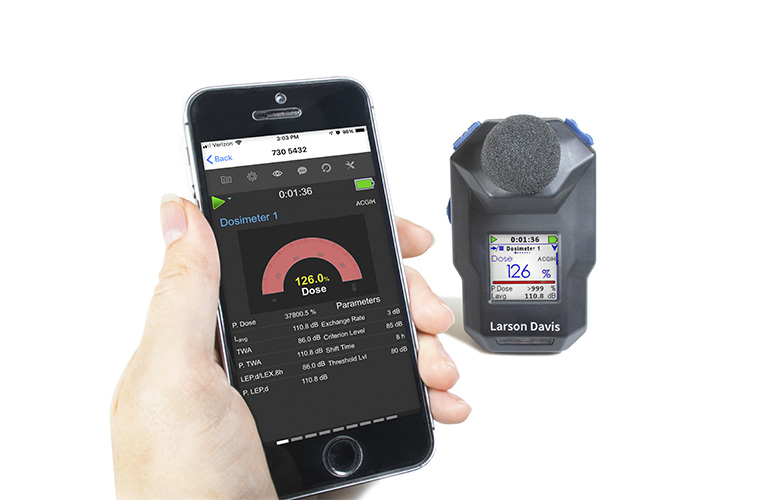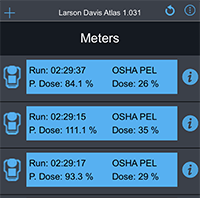 Larson Davis' Noise Dosimeters are typically used in workplaces
such as industrial environments, but where else can noise be dangerous? We've all seen a marching band, whether in a parade or at a high school football game. Our team was curious: are the members of the band at risk of hearing loss due to noise exposure?
A local high school band director volunteered to help us find out! In the process, we learned a lot about the practical deployment of our Spartan™ Wireless Noise Dosimeter Model 730.
Larson Davis' Noise Dosimeters are typically used in workplaces
such as industrial environments, but where else can noise be dangerous? We've all seen a marching band, whether in a parade or at a high school football game. Our team was curious: are the members of the band at risk of hearing loss due to noise exposure?
A local high school band director volunteered to help us find out! In the process, we learned a lot about the practical deployment of our Spartan™ Wireless Noise Dosimeter Model 730.
We attended band practice on a blustery fall evening. As the students streamed into the stadium for practice, we identified our ten pre-chosen musicians, made note of each noise dosimeter serial number, and clipped a dosimeter on the shirt at the shoulder
of each student. We made an effort to pick a wide range of instruments. (And thanks to the durability of the dosimeter, we didn't worry too much when the sousaphone player almost rested his instrument right on top of the device!)
Deploying ten dosimeters amongst a large group of high school students arriving for band practice may seem like an overwhelming job, but several features of the Spartan made it easier than expected:
- Charge and Transport Easily: Multi-packs of dosimeters from 3 to 10 makes charging and transporting the devices convenient. The dosimeters can be charged on wireless charging pads right inside the case. A 3-hour charge typically results
in 40 hours of power in the field.
- Set up Once, Deploy Many Times: Free-to-download G4 LD Utility software allows a setup file to be sent to as many dosimeters as needed.
- Quickly Calibrate: Calibration is as simple as removing the wind screen with a quarter turn, placing the running calibrator over the microphone, and accepting the results. No need to scroll through menus to start calibration - as
soon as the dosimeter recognizes the steady 114 dB (1 kHz) tone, calibration begins automatically.
- Run Automatically: Timed mode allows all dosimeters to start and stop running at specified times. There is no need to press "Run" on each device, and time history data from each can be synchronized easily in post-processing.
- View Live Data: Bluetooth Low Energy (BLE) allows the person deploying the systems to interact with nearby dosimeters in real-time using a mobile device. They can even view data from multiple meters at once.
Back in the office, sifting through all that data was straightforward, too.
- Detect Bumps: The built-in accelerometer detects bumps and automatically removes the data associated with them - a microphone bump can cause a very loud peak that doesn't represent the actual noise exposure for the user.
- Detect and Manage Tampering: Hand a student (or almost anyone, really) a high-tech microphone, and you can be sure they'll want to mess around with it. Someone blowing a horn or yelling directly into the microphone can drastically
impact the data, offering results that are far out-of-line with reality. Optional sound recording (set to record for a few seconds when the noise level exceeds a specified threshold) lets you go back to hear what's really causing the noise. If
it's tampering, that event can be removed from the data. Like the time the piccolo player asked a friend to try yelling directly into the microphone: removal of just those couple of seconds of data changed the student's noise dose significantly.
- Automatic Connection and Data Download: As soon as the device connects (either wirelessly with Bluetooth Low Energy or via USB connection) to the app or G4 LD Utility software, data download begins.
- Create Reports from Your Mobile Device or Computer: Create and share reports with data like Dose,
Projected Dose, LAeq, Time History, and more with just a few clicks or taps.
- View and Export Detailed Data: Access one-second time history data, graphs, and sound clips from G4 Software.
So, what were the results of our study? According to OSHA guidelines, none of the students reached their daily noise dose
limit during the two-and-a-half hour practice. However, if comparing the exposure to more stringent ACGIH guidelines, six of the students did experience levels of noise that could be hazardous to their hearing, especially if that exposure were occurring
on a daily basis. Wear that hearing protection, kids!
Marching Band Noise Dose Comparison Graph

 Larson Davis' Noise Dosimeters are typically used in workplaces
such as industrial environments, but where else can noise be dangerous? We've all seen a marching band, whether in a parade or at a high school football game. Our team was curious: are the members of the band at risk of hearing loss due to noise exposure?
A local high school band director volunteered to help us find out! In the process, we learned a lot about the practical deployment of our Spartan™ Wireless Noise Dosimeter Model 730.
Larson Davis' Noise Dosimeters are typically used in workplaces
such as industrial environments, but where else can noise be dangerous? We've all seen a marching band, whether in a parade or at a high school football game. Our team was curious: are the members of the band at risk of hearing loss due to noise exposure?
A local high school band director volunteered to help us find out! In the process, we learned a lot about the practical deployment of our Spartan™ Wireless Noise Dosimeter Model 730.

